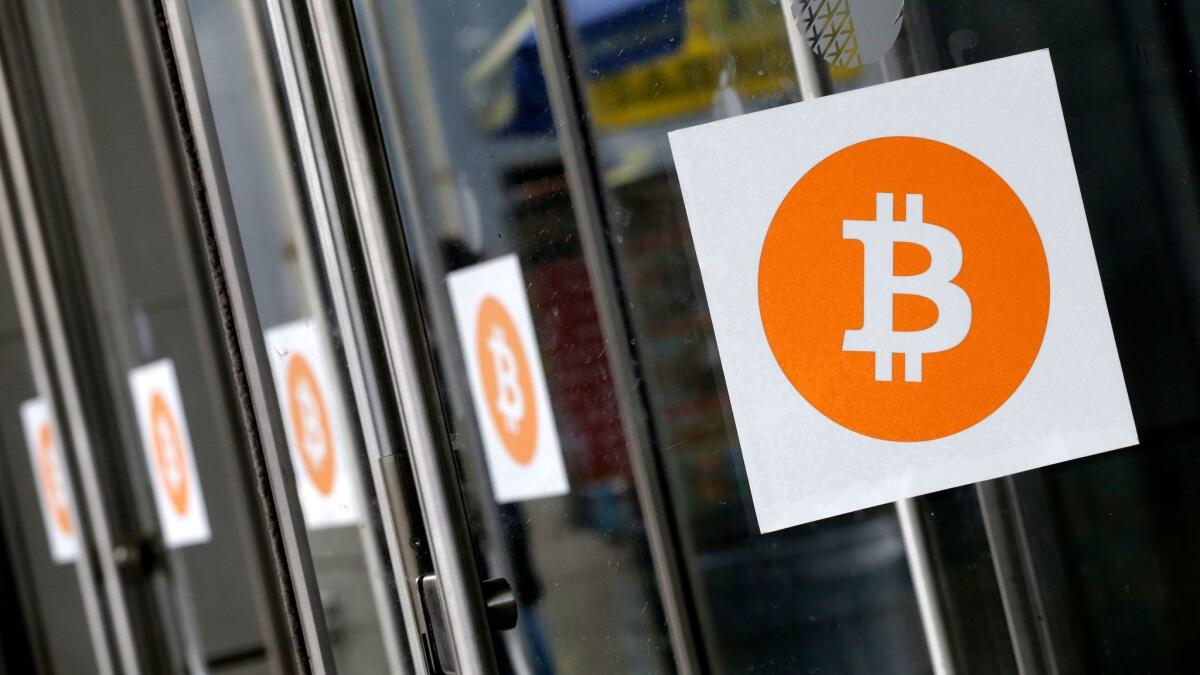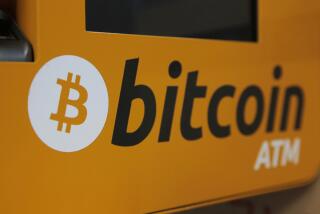Column: Bitcoinâs price hit $5,000 last week. Itâs still a dumb investment

Late last week, I noticed a spike in what we might think of as a certain financial index. It wasnât the trading in a financial instrument per se, but in the online traffic in a column I had written in December 2013. The column examined the recent crash in the price of bitcoins, which had plummeted to $600 from $1,200 in just two days. The headline read:
âThe bitcoin crash of 2013: Donât you feel silly now?â
What was causing the spike in readership of that piece more than three years later was that the price of bitcoins was surging toward $5,000, a point it breached during the day on Friday. A few bitcoin true believers had dug out that old story and were, metaphorically, waving it in my face. Tweets citing the piece and asking if it wasnât me who should be feeling silly came pouring into my Twitter feed. Suddenly I was a meme.
So hereâs my short answer. No, I donât feel silly, but vindicated. If the recent run-up in bitcoin price proves anything, itâs that the virtual currency is still a dumb investment.
Not only that, but the surge undermines the case for bitcoinâs ostensibly chief purpose, as a medium of exchange. To understand why, we can start by scrutinizing the recent bitcoin surge â or as financial historians might view it, the bubble.
Since Bitcoin is not backed by an underlying asset and instead has a fully fluctuating exchange rate... the idea of bubbles seems salient.
— Susan Athey et.al, Stanford University
First, the surge is of very recent vintage. From the end of 2013 through January this year, bitcoin as an investment was essentially dead money: Leaving aside some peaks and valleys, it traded in the $800 to $900 range in December 2013, and about the same in December 2016. (Iâm using coindesk.com price quotes as a benchmark.) Bitcoin crossed the $1,000 barrier in earnest around the end of January and really took off at the end of March. From then through last week, bitcoin quintupled in price. Since bitcoins were introduced only in 2009, the surge represents only a narrow sliver of a very brief lifespan. Tulips live longer.
Whatâs more, Fridayâs peak was gone by Saturday, when the price fell to as low as about $4,600. Thatâs a drop of 8% in a matter of hours. Is that significant? Think of it this way: If the Dow Jones Industrial Average fell by 8% in a day, that would be a plunge of more than 1,700 points. Most market participants, itâs safe to say, would regard a one-day collapse of that magnitude as cataclysmic. Since Saturday, by the way, bitcoin has continued to head lower. As I write, itâs quoted at about $4,350.
âBitcoins will undoubtedly rise in quoted value again, and also fall again,â I wrote in 2013. âThe one inevitability about them is their volatility, to which thereâs no end in sight.â
Thatâs still true. As an investment, therefore, bitcoin is not for the average household. Even professional plungers might quail at such a volatile financial instrument.
What about people using bitcoin as a medium of exchange? Among bitcoinâs virtues, ostensibly, is that itâs anonymous, and theoretically easy to convert into or out of national currencies. This makes it relatively convenient for anyone needing to move financial assets around, out of the eyesight of government foreign exchange regulators, tax authorities or law enforcement agencies. The infamous Silk Road black market for drugs took payment exclusively in bitcoins until it was busted in 2013, for example. Ransomware perpetrators, who lock up institutionsâ computers until theyâre paid off, typically prefer bitcoins.
Bitcoin is popular among businesspersons in places such as Greece, Spain and China, where the impulse to get capital out of the country confronts strict government policies aimed at keeping it in. You can buy bitcoins from home and convert it into dollars, sterling or euros. These transactions are anonymous and electronic, typically performed via a virtual âwalletâ maintained at a bitcoin exchange firm. Your capital exists in cyberspace, everywhere and nowhere like Schrodingerâs quantum cat, until you convert it into a recognized currency and deposit it in a safe offshore account.
Yet most bitcoin value appears to be held by investors, not used for trading or capital flight. Thatâs the conclusion of a research team headed by Susan Athey of Stanford. In an August 2016 paper, the researchers observed that the risk of bitcoin investing derives from the fact that itâs almost entirely virtual, with its supply governed â if thatâs the right word â by a mathematical algorithm. (Bitcoins are âcreatedâ by users of supercomputers solving an increasingly complex mathematical puzzle; by its terms, the supply of bitcoins can never exceed 21 million.)
âSince Bitcoin is not backed by an underlying asset and instead has a fully fluctuating exchange rate.â they wrote, âthere is substantial risk about its future value.â Under those circumstances, âspeculative âbubblesâ can form⌠given many of the fluctuations that have occurred with Bitcoin exchange rates, the idea of bubbles seems salient.â We may be in one right now.
That should give pause to anyone using bitcoins to transfer value. Consider yourself a Chinese or Greek business person using bitcoins to spirit, say, $50,000 in your local currency abroad. You convert that to 10 bitcoins at the peak last week; if you wait more than a day to convert it out of bitcoins, you get only $45,000 back. Wait until today, and youâre down to $43,000. Thatâs a sizable transaction tax.
Factor in the instability of bitcoin exchange firms, which have experienced a string of failures, technical problems and government seizures tied to criminal activity for almost as long as there have been bitcoins. The bitcoin thesis is that its mathematical underpinning eliminates the need to rely on trust relationships with oneâs transaction counterpart, as long as one trusts the algorithm. But when the firm holding your âwalletâ shuts down, who do you trust then?
This may be why bitcoin still accounts for a minuscule proportion of financial transactions worldwide. The capitalization of the bitcoin market â that is, the 16.5 million bitcoins in existence multiplied by $4,350 each â comes to just under $71.8 billion. The worldwide stock of âbroad money,â which includes notes, coins and financial accounts, was placed at $82 trillion by the CIA as of the end of 2016. In market cap, bitcoin ranked just ahead of the Romanian leu, in 60th place â and that was only after its quintupling in price this year. For comparisonâs sake, the market value of all U.S. dollars alone as of Dec. 31 was $13.2 trillion.
What bitcoin has that the Romanian currency lacks is a fan base that sees it in ideological terms. These fanatics believe that itâs a viable alternative to what they call âfiatâ money, which is currency subject to central bank buying and selling. The central banks, they further believe, are devoted to maintaining inflation, which can only sap those currencies of their value over time.
What they donât acknowledge, however, is that bitcoin is even more vulnerable to externalities such as government policies. Experts seeking to explain this yearâs bitcoin bubble have pointed to factors including a âspeculative hysteriaâ akin to the tulip mania of the 1600s or the South Sea bubble of the 1700s; and more welcoming policies enacted in Japan and Korea. On the other side of the cliff, however, the subsequent fall in prices has been blamed in part on a hostile policy issued by the central bank of China.
The real value of bitcoin may reside not in the price of these virtual coins, but the underlying technology, which is known as the blockchain. Blockchains, put simply, are ledgers or databases that arenât maintained by a government agency, corporation or other centralized authority, but their community of users. Theyâre encrypted to prevent unauthorized or secret tampering, which makes them especially secure. Bitcoin can be viewed as blockchainâs proof of concept.
Indeed, bitcoin is facing competition from other virtual currencies purporting to exploit blockchain more effectively. Investors are pouring into the blockchain space, hoping to get in on the ground floor of a technology with broader application for business and government than merely as a way to move money around.
That doesnât mean those investors have much faith in the market price of bitcoin. As is often the case in financial markets the real money is to be made via investments for which the actual value of the underlying asset is irrelevant. (Thatâs why brokers prefer to take a commission on every transaction, regardless of its price.)
As I wrote in 2013, bitcoin may well rise in price, but it may also fall â after all, itâs done both, big time, in the last week. As an investor you may end up getting rich. But you may also end up looking very, very silly. Whether the price is $1,000 or $5,000, that will always be true.
Keep up to date with Michael Hiltzik. Follow @hiltzikm on Twitter, see his Facebook page, or email [email protected].
Return to Michael Hiltzikâs blog.
More to Read
Inside the business of entertainment
The Wide Shot brings you news, analysis and insights on everything from streaming wars to production â and what it all means for the future.
You may occasionally receive promotional content from the Los Angeles Times.











